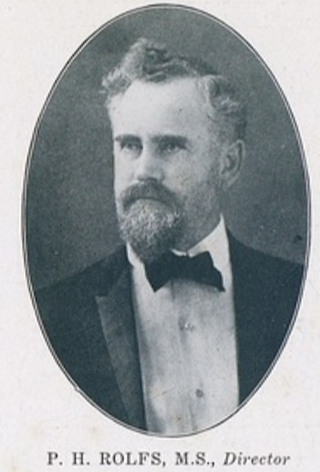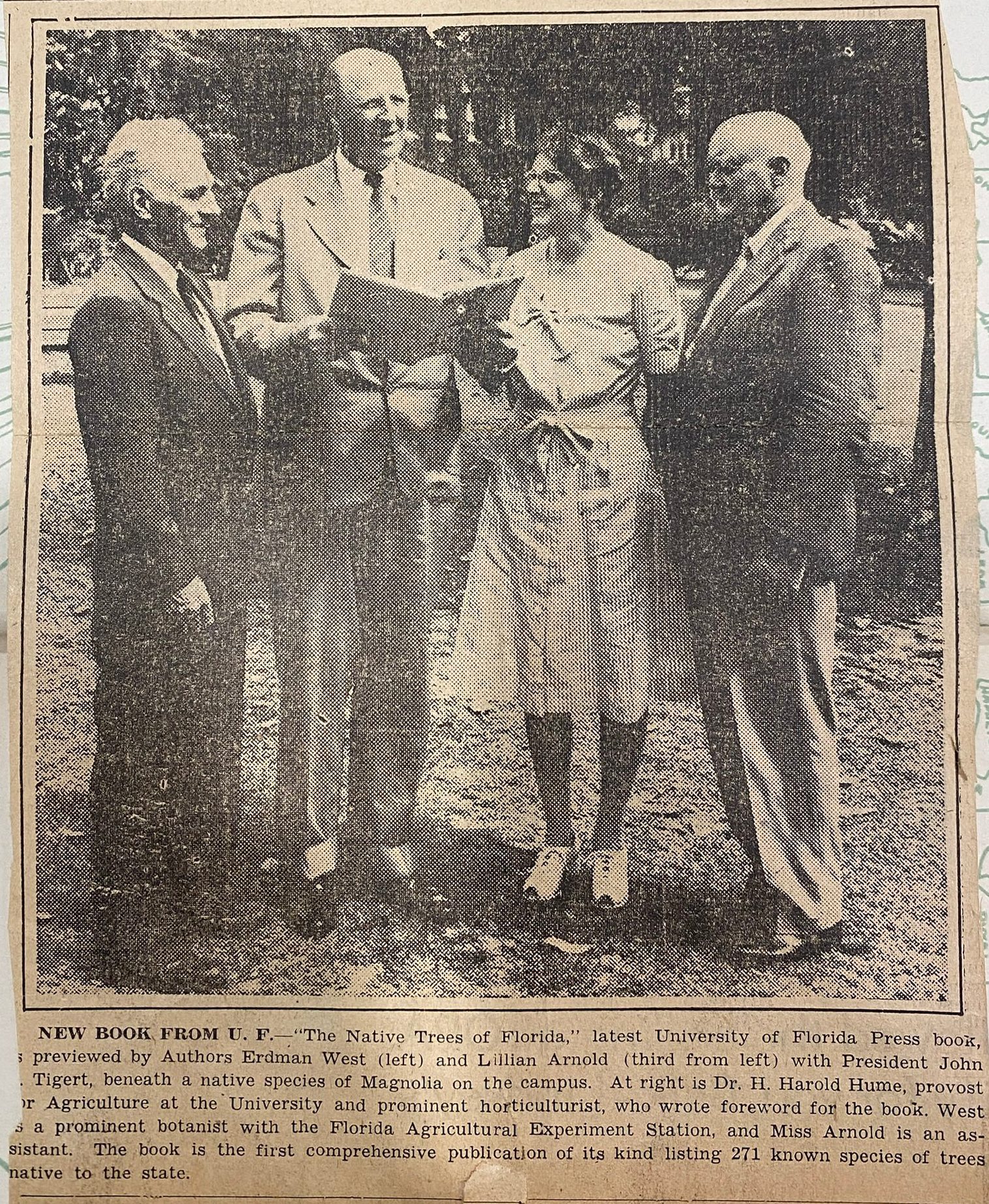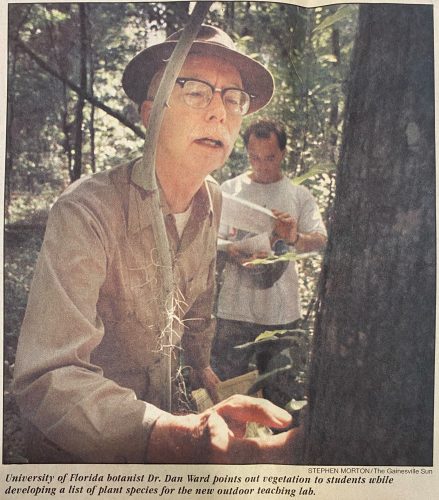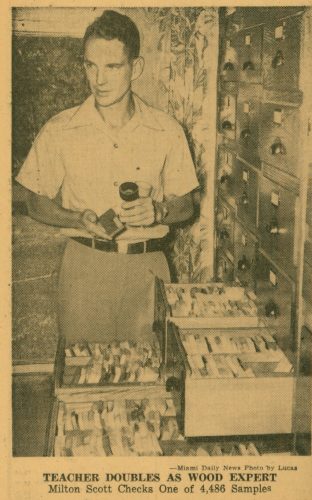In late 1891, Peter Henry Rolfs began collecting specimens of wild plants in Florida, essentially marking the formation of the University of Florida Herbarium.
 The University of Florida Herbarium (FLAS) contains about a half million specimens, including about 350,000 vascular plants, 70,000 bryophytes, 20,000 lichens, 3,500 algae, 16,000 wood samples, and 60,000 fungi (non-lichenized). It is the oldest herbarium in Florida, founded in 1891 in Lake City (Columbia County), through the efforts of Peter Henry Rolfs (1865-1944), professor of Natural Science for Florida State Agricultural College (or Florida Agricultural College, est. 1884 and previously named State Agricultural College of Florida) and horticulturist and biologist for the Florida Agricultural Experiment Station (est. Mar 1888). The FLAS acronym (standardized by the Index Herbariorum) is derived from the terms Florida Agricultural Station.
The University of Florida Herbarium (FLAS) contains about a half million specimens, including about 350,000 vascular plants, 70,000 bryophytes, 20,000 lichens, 3,500 algae, 16,000 wood samples, and 60,000 fungi (non-lichenized). It is the oldest herbarium in Florida, founded in 1891 in Lake City (Columbia County), through the efforts of Peter Henry Rolfs (1865-1944), professor of Natural Science for Florida State Agricultural College (or Florida Agricultural College, est. 1884 and previously named State Agricultural College of Florida) and horticulturist and biologist for the Florida Agricultural Experiment Station (est. Mar 1888). The FLAS acronym (standardized by the Index Herbariorum) is derived from the terms Florida Agricultural Station.
Before arriving at FLAS, Rolfs was active with herbarium collections at Iowa State College until the fall of 1891. He moved to Lake City shortly thereafter, his first Florida collections being made around December 1891, marking the formation of the FLAS herbarium. He continued collecting specimens for the herbarium until the summer of 1898. One of the early stated goals was “that every plant [species] of the state, introduced or native, shall be represented” in the herbarium.
These early Rolfs collections bear labels with the heading “Herbarium of Florida Agricultural College” and numbers on the labels correspond to an inventory list in the Rolfs library archives. Much of this inventory list was written by Albert S. Hitchcock, who appended a note “Shall be glad to have a grass and sedge at any time.” About 900 of these early collections were identified by A.S. Hitchcock, possibly in the summer of 1898 when Hitchcock was in Lake City and collecting some of his own specimens. Correspondences with Rolfs from this period indicate that the herbarium carried on an active exchange with several mid-western institutions. Probably an exchange took place with a set of about 50 grasses collected by Rolfs ending up in the Smithsonian herbarium and a nearly equal number of Hitchcock (then based at Kansas State Agricultural College) specimens from Eustis (Lake County) ending up at FLAS. The Station’s veterinarian Arvill Wayne Bitting also collected a smattering of specimens in 1892.
The 1898–99 catalogue of the College detailed the herbarium’s holdings consisting of 5,000 sheets from 1,400 species, and 150 lichens (esp. those of W. W. Calkins). Rolfs left FLAS in August 1899, headed to Clemson Agricultural College, and then became the director of the U.S. Semi-tropical Laboratory in Miami in 1901. He made a few collections in 1903–1904 (deposited at NY, PH, none at FLAS). Succeeding Rolfs as Botanist and Horticulturist was Hardrada Harold Hume in September 1899, who like Rolfs had transferred from Iowa State College. Some early Hume specimens were collected in October 1899. In 1901, Lucia McCulloch began making herbarium collections. McCulloch was a biology student who then became the librarian for the station in 1898 and by 1902 was an assistant biologist. From 1903–1905, the Lake City College was renamed the University of Florida (UF), and a few collections bear this name, such as those from Frank Charles Reimer, who received his M.S. in 1905.
In 1905, Gainesville was selected as the site for the University of Florida. The herbarium was moved by covered wagon to Gainesville in 1906. The Florida Agricultural College and the Agricultural Experiment Station were consolidated with the Kingsbury Academy of Ocala to form the University of Florida. That same year, Rolfs returned as director of the Station (which he held until 1921). Howard S. Fawcett joined the staff in 1905 and developed a considerable fungal collection. In 1907 the cryptogamic collection was greatly increased by the addition of 2,500 specimens from the Fungi Columbiani set (prepared by E. Bartholomew).
In 1914, Thompson Van Hyning came to Gainesville as the Museum’s first director at UF, having previously been the director of the Iowa State Museum. He helped to draft the bill that in 1917, Florida Statute Ch. 240.515 established Florida State Museum at UF, although the FLAS herbarium was not yet formally part of the Museum. Around the same time, ca. 5,000 specimens from Samuel C. Hood and the plant holdings of the Florida State Museum were donated to the FLAS herbarium. In 1922, George F. Weber joined the Florida Agricultural Experiment Station, the start of a long career in plant pathology.
 By 1925 the herbarium collection had crept up to ~6,000 sheets of higher plants and ~5,000 packets of fungi. Later that year, Erdman West was hired in the Plant Pathology department, and in 1927 Lilian Arnold was employed as stenographer of the department. They cooperated in countless research projects and offered plant identification as a service in the Florida Cooperative Extension Service. In 1924, Reverend Hugh O’Neill of the College of Pharmacy and, in 1926, the famous mycologist William M. Murrill both became active with FLAS herbarium collections. Up to 1927, the herbarium was housed in wooden cases in the hall of the old Experiment Station building, but in 1928 a room in the Horticultural Building was reserved exclusively for the herbarium. And, between 1927–1935, 15 steel cases were added. In 1931, Hume became Assistant Director for the College of Agriculture, maintaining significant activity with the herbarium. In the same year, the entire herbarium was moved to the 3rd floor of the Horticultural building, which suffered from a leaking roof and flooded room on several occasions. At this time, paradichlorobenzene was in use a pesticide to protect the specimens. In October 1932, the General Edmund Kirby-Smith collection of ca. 6000 specimens was donated to the Department of Pharmacognosy (College of Pharmacy) and held there as a separate collection. Over a 1,000 specimens from Alfred Cuthbert were donated to FLAS.
By 1925 the herbarium collection had crept up to ~6,000 sheets of higher plants and ~5,000 packets of fungi. Later that year, Erdman West was hired in the Plant Pathology department, and in 1927 Lilian Arnold was employed as stenographer of the department. They cooperated in countless research projects and offered plant identification as a service in the Florida Cooperative Extension Service. In 1924, Reverend Hugh O’Neill of the College of Pharmacy and, in 1926, the famous mycologist William M. Murrill both became active with FLAS herbarium collections. Up to 1927, the herbarium was housed in wooden cases in the hall of the old Experiment Station building, but in 1928 a room in the Horticultural Building was reserved exclusively for the herbarium. And, between 1927–1935, 15 steel cases were added. In 1931, Hume became Assistant Director for the College of Agriculture, maintaining significant activity with the herbarium. In the same year, the entire herbarium was moved to the 3rd floor of the Horticultural building, which suffered from a leaking roof and flooded room on several occasions. At this time, paradichlorobenzene was in use a pesticide to protect the specimens. In October 1932, the General Edmund Kirby-Smith collection of ca. 6000 specimens was donated to the Department of Pharmacognosy (College of Pharmacy) and held there as a separate collection. Over a 1,000 specimens from Alfred Cuthbert were donated to FLAS.
In 1935 the collection contained about 19,000 sheets of higher plants and 14,300 collections of fungi. Around 1936, a seed collection was initiated, and by 1938 a wood collection had also been started. In 1939, the abbreviation for the herbarium (FLAS) was officially established in a publication in Chronica Botanica (incipient to the Index Herbariorium). Some time around 1943–1944, a formal herbarium logo stamp and accession numbers were added to the specimens. The stamp contained the text Herbarium, Agricultural Station, University of Florida at Gainesville. Accession number 1 was given to a Hume collection of Zephyranthes treatiae collected in 1938 from Gilchrist County. Shortly after Severin Rapp’s death in 1942, his collections of several 1000s of lichens and mosses were donated to the herbarium. And at this time, these cryptogamic packets were mounted on sheets, up to 10 per sheet.
 According to an 1948 report (by Jones & Meadows in the American Midland Naturalist), the collection rapidly grew to an estimated 100,000 specimens with West (as botanist) and Arnold (as acting curator), and Hume was credited as founding the herbarium in 1902. Hume retired as Provost for Agriculture on 30 June 1949. In the 1950s, George R. Cooley (who later helped establish the University of South Florida herbarium) corresponded frequently with the FLAS herbarium, helping to fund its activities. As Associate Botanist and Curator, Arnold retired on 16 May 1958. Soon thereafter, Daniel B. Ward was hired as Assistant Botanist for the Botany Department on 1 Sep 1958, and by 1960 the collections swelled to 138,880 specimens. On 30 Jun 1964, West retired, and a day later James W. Kimbrough was hired as Assistant Mycologist for the Plant Pathology Department on 1 July 1964. Around late 1967, Dana Griffin, III arrived to UF, a prolific bryologist and lichenologist. In the summer of 1971, the Kirby-Smith collection was transferred to the FLAS herbarium. In the same decade, the wood collection of Milton F. Scott (~7,000 specimens) was donated to FLAS (transferred from the School of Forest Resources and Conservation).
According to an 1948 report (by Jones & Meadows in the American Midland Naturalist), the collection rapidly grew to an estimated 100,000 specimens with West (as botanist) and Arnold (as acting curator), and Hume was credited as founding the herbarium in 1902. Hume retired as Provost for Agriculture on 30 June 1949. In the 1950s, George R. Cooley (who later helped establish the University of South Florida herbarium) corresponded frequently with the FLAS herbarium, helping to fund its activities. As Associate Botanist and Curator, Arnold retired on 16 May 1958. Soon thereafter, Daniel B. Ward was hired as Assistant Botanist for the Botany Department on 1 Sep 1958, and by 1960 the collections swelled to 138,880 specimens. On 30 Jun 1964, West retired, and a day later James W. Kimbrough was hired as Assistant Mycologist for the Plant Pathology Department on 1 July 1964. Around late 1967, Dana Griffin, III arrived to UF, a prolific bryologist and lichenologist. In the summer of 1971, the Kirby-Smith collection was transferred to the FLAS herbarium. In the same decade, the wood collection of Milton F. Scott (~7,000 specimens) was donated to FLAS (transferred from the School of Forest Resources and Conservation).
In 1976, Kent P. Perkins became collections manager for plants and lichens. A vital set of Ferdinand Rugel specimens (many from the 1830s and 1840s from Florida) were received from the British Museum in November 1978 and another set received in 1981 from the U.S. National Arboretum. In 1979, the herbarium curator was administratively transferred from IFAS to the Museum, with Walter S. Judd as interim curator, replacing Ward. In the same year, William L. Stern became professor and chair of the Botany Department, helping to develop the wood collection. Through their combined efforts the collections nearly doubled to almost 250,000 specimens by 1980.
FLAS was administratively transferred from the Department of Botany to the Department of Natural Sciences of the Florida State Museum in 1981. Concurrent with this transfer, Norris H. Williams, coming from Florida State University, became Curator and also brought his graduate student William Mark Whitten. In 1988, the museum was renamed as the Florida Museum of Natural History. Around the same time, a set of largely neotropical specimens from the Fort Pierce Agricultural Research & Education Center administered by Albert E. Kretschmer, Jr. were received and the FLAS collection surpassed 170,000 specimens.
In 1989, Angus K. Gholson, Jr. formally donated his entire herbarium (~15,000 specimens mostly from the Panhandle region), library, and related equipment and supplies to the FLAS herbarium (retained at his home in Chattahoochee until the move to Dickinson in 1997). In the early 1990s, the seed collection was renovated to use glass vials with screw-on caps, replacing clouded plastic and glass vials with cotton or cork stoppers.
Ward officially retired in 1995, and afterwards he remained active with herbarium studies. In the 1990s, the wood collection of George C. Bucher (~2,000 specimens) was donated to FLAS. In late 1997, the herbarium was moved to Dickinson Hall (and compactors installed soon thereafter). Before this, the vascular plant herbarium was on the 2nd flood of Rolfs Hall [shown in header image above] in seven rooms (rooms 201, 203, 205, 207, 207A, 209, 209A, and 211) and 34 cases were in the hallway. Almost every three months, the entire herbarium was fogged with pyrethrins (Turbocide) mixed with methoprene and boric acid (PreCor). The pest management system was transitioned to freezing incoming specimens for about two weeks, and UF Pest Control would fumigate Dickinson Hall with Vikane every 5 years or so, sometimes spot treating with paraidchlorobenzene for book lice.
Online digitization efforts began in 2001, with assistance from the UF Libraries Digital Library Center. The same year, Dana Griffin, III, retired, and the herbarium assumed the duties of bryophyte and lichen curation. Stern retired in 2002. From 2002–2008, Marc S. Frank was the plant identification specialist. By 2006, about 45,000 specimens were transcribed and 5,000 imaged (esp. type specimens, invasives, carnivorous species, poisonous plants, and Kanapaha garden plants). By 2008, there were about 8,600 specimen images (esp. Florida’s listed species) and also in 2008 a $100,000 HVAC system was installed in the compactor room, keeping the environment at or around 68°F and 45% relative humidity. In 2011, a project to digitize type specimens was supported by the Mellon Foundation. Large-scale digitization of the bryophytes and lichens from North America began in 2012 with support from NSF, and in the same year cultivated plants were targeted for digitization with support from the USDA. In 2013, digitization of the algae collection ensued with support from NSF and in the same year the White Oak herbarium was donated. In 2014, an NSF-supported project facilitated digitizing a large portion of the vascular plants specimens from the southeastern USA. In 2016, Frank became IFAS extension botanist. Norris retired in 2018 and in the same year Lucas C. Majure was hired as curator. In 2021, digitization of the rest of the bryophytes and lichens was supported by an NSF grant.
Written by: Kent Perkins (last revisions 25 Jan 1995); revised and expanded by A.R. Franck (first revisions 9 Jan 2024) [permission for Gainesville Sun photo of Ward given by Cleveland Tinker, editor, email 10 Jan 2024].
Transfer of the Herbarium from IFAS to the Museum – Important Documents
1972 Documents between Dr. John W. Sites, Dean for Research, IFAS, and Dr. J.C. Dickinson, Jr., Director of the Florida State Museum
- Overview and Proposal – prepared by Dr. Sites.
- Letter from J.C. Dickinson to J.W. Sites in response to the proposal.
1978-1981 Documents including Final Agreement
- Letter from Dr. Graig Shaak to Dr. J.C. Dickinson – discussion of the transfer and the issues involved. 28 Aug 1978.
- Herbarium Committee Report to Vice President Dr. Robert A. Bryan. 18 Jan 1979.
- Letter from Dr. Robert A. Bryan to Dr. Kenneth Tefertiller, Vice President of Agricultural Affairs. 14 Feb 1979.
- Letter of IFAS commitment from Dr. F. Aloysius Wood, IFAS Dean for Research, to F. Wayne King, Director of the Florida State Museum. 16 Mar 1981.
- Letter regarding commitments from Dr. Robert A. Bryan to Dr. Charles A. Woods, Chairman, Department of Natural Sciences, Florida State Museum. 16 Mar 1981.
- Final Transfer Agreement. 23 Mar 1981.
Ward Arbitration
- Ward Arbitration 1 – results of the 1st meeting. 19 Sep 1983.
- Ward Arbitration 2 – results of the 2nd meeting. 25 June 1984.